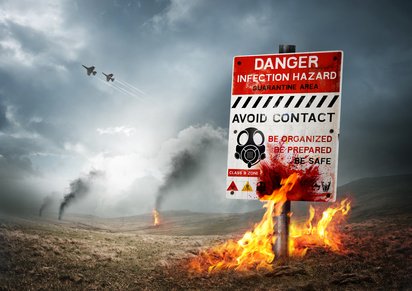Danger Infection
 Knowing When It’s Time to Bug Out
Knowing When It’s Time to Bug Out
Those who are prepared for survival situations know that a bug out may come. A bug out is exactly how it sounds. It means it’s time to get out of dodge. Bugging out may mean you’ll have to get where you’re going by walking.
If this is the case, then you need to make sure that you have sturdy shoes or boots – and the means to have food and shelter if it’s going to be a long trek. Being prepared for this scenario means having a bug out bag where you can get to it when the time comes for you to go.
Bugging out by vehicle means that you’re leaving in a vehicle that’s already prepared ahead of time for a bug out. Your vehicle is gassed up and ready to go within seconds.
It’s time to bug out when the place you’re at is no longer safe – or could be compromised – and survival may become an issue. This means you need to be prepared to bug out in the event of a weather emergency, a terrorist attack, a flash mob or a riot.
You also need to leave fast if there’s a contaminate set loose in your area – such as a train derailment and the train was carrying some nasty hazardous materials that escaped into the air. City-wide black outs are a criminal’s favorite time to come out and wreak havoc. Your possessions aren’t worth losing your life over – so leave.
If there’s been a city-wide breakdown of communication resources, like if the 911 system crashes, get out. These systems are all computer run – and when the computer crashes, you’re on your own. When a city goes down, law and order goes out the window and chaos ensues.
If something nasty is headed your direction and it’s not looking good, get out before the government officials tell you to get out. Why? Because there will always be thousands who wait until the last possible minute to leave creating a zombie buffet – and you may end up trapped in your vehicle sitting still on an interstate while a harrowing crap storm bears down on you.
Plan ahead of time to take an alternate evacuation route, since the main roads will be overrun by people trying to leave. Print out your escape routes and have them where you can get to them easily.
Know where you’re going. Don’t just hop into your vehicle and take off. Plan ahead for every possible emergency. Have your kit or bag ready to take with you when you go. Inside the bag, you should have water, food, first aid, a way to take care of shelter – like a sleeping bag or poncho, flashlights and personal safety tools like Mace or weapons.
Make sure you pack a battery-operated or hand crank radio so that you can listen for emergency broadcasts. Have a way to start a fire and make sure you have a change of clothes.
What Kind of Survival Clothing Should You Pack?
You never know when you’re going to have to get out in a hurry. Having a bag packed with all of the necessities you need – including clothing – will allow you to be prepared for any situation.
You already know that you should have the basic items like food, water and first aid. When it comes to clothing, it can be a little confusing knowing exactly what or how much to pack.
A good rule of thumb to follow would be to pack as if you’re going to be gone for three days. You’ll also want to consider exactly where you’re going when choosing what clothing to pack because the area you’re going to may have different weather than where you’re currently living.
If you’re heading to a rainier area, then you’d want to make sure you had rain gear – and if you’re going to an area where the weather is colder, you’ll want warmer clothing. Since room can be limited in a backpack, you want every piece of clothing to serve a purpose.
Pack two pairs of pants to wear. Since you’ll be wearing a pair, that counts as your third day pair. You’ll want to take long pants rather than shorts since you might be hiking through rough terrain. Plus, having long pants can help protect your legs against insect bites.
Take two shirts along for the journey. You’ll need one that’s fit for warmer weather – such as a short sleeve t-shirt. But you’ll also want a long sleeve shirt for cooler temperatures. Remember that temperatures always drop in the evening hours. By having both a short sleeve and a long sleeve shirt, you can double these up for warmth if needed.
For undergarments, you’ll need to take two pairs of socks and two pairs of underwear – but you’ll also want to pack a pair of thermal underwear. You can wear these under your clothing in the event of cold weather.
You’ll want to take along a hat to protect your head from the sun’s rays as well as to keep your head warm if it’s cold. A hat can also be useful to keep the rain out of your eyes.
A jacket is a must-have clothing item, but you want one that can serve two purposes. You want one that help you keep you warm but can also protect you from inclement weather like rain.
Many jackets have a waterproof shell and are lined with warm material on the inside. You can find some that are lightweight so that fitting them in your backpack won’t be an issue.
Don’t forget to pack footwear. When you first start out, it’s best to wear your waterproof boots and pack a pair of athletic shoes. Break them in ahead of time to prevent blisters if you have to hike around a lot.
Bug Out Bag Essentials
Surviving in short term and long term emergency situations will depend on how well prepared you are to meet the basic needs of yourself and your family. More than ever, many people are seeing the wisdom in having the essentials they need to survive packed and ready ahead of time.
These survival essentials include all of your basic needs like food, water, shelter, protection and first aid. When you’re preparing for survival, you have to think of both your long term as well as your short term survival.
You need to be ready to leave your home in seconds if the worst should happen. You need guidance so that you can be prepared to effectively handle all of your survival needs, so here’s a look at some of the most important things you can prepare.
The Short Term: Why Do I Need a Bug Out Bag?
Sometimes, you can bug out (which means get out of wherever you’re out and get to a secluded spot) by making it to a vehicle and driving to your next meet up place.
But if you can’t, maybe because the roads are impassable due to weather or unsafe due to individuals that are roaming the roads, you need to have your gear stowed in a bag that you can sling over your shoulder and go.
These bags are usually made of sturdy, waterproof canvas. A bug out bag is a bag filled with the basic gear that you’re going to need to have with you in order to make it for at least three days.
Some people also refer to these bags as their 72-hour bag. The items that go into this bug out bag are the things that you absolutely have to have so that you can make it to your next step of survival.
This is also the bag that you need to grab in that moment when you have to leave and rendezvous at whatever pre-arranged destiny you’ve planned for yourself or your family.
You’ll want to keep this bag in a place where you can get to it fast and get out the door if necessary. Some serious survivalists also keep multiple bug out bags handy – one at home, one in the car, and one at work, so that they’re fully prepared no matter what.
What Goes Into the Bug Out Bag?
There are several things that need to be in your bag and all of them are important – but the top three items will be your water, food and shelter. The body can’t survive without having enough water to drink.
The last thing you want to end up doing is being afraid that you’re not going to have the water that you need. You have to have water inside your bag because in the event of some kind of catastrophe, there’s no guarantee that you’ll find immediate access to clean water.
Even if you live near a large body of water, there’s no guarantee that you can get to that water if the roads are blocked off or it’s been compromised in some way. Since your survival depends on water, you’ll want to have a water for every person who’s going to be with you.
You’ll need to figure out your water supply based on the formula of 1 liter x 1 person x days. Since a bug out bag is a 72-hour bag, your formula will figure in 3 days.
If you have 3 people in your family, you would take 9 liters of water. This is only a temporary solution to your water needs. So you’ll need to know ahead of time what you’re going to do at the end of the 72 hours, and take purifiers to help cleanse natural water that you find on the go.
Food is something else you need in the bag. Remember that the bug out bag is a short term solution only. The food items that you put in the bag will be simple foods that can last the 72 hours.
Short term foods are items such as granola bars or energy bars. You can buy energy bars that contain 2,400 calories per bar which would give each person the calories they needed to survive for each of the three days.
You’ll need to pack a temporary shelter in your bug out bag. This can consist of single person tents, multiple person tents or a tarp. You’ll also need a sleeping bag. A survival blanket can also be a handy addition in case of cold weather.
Taking along a couple of complete sets for your clothing changes is also an essential need. Some people also choose to take along rain ponchos. You should pack a pair of sturdy shoes or hiking boots if you plan to be out in nature the whole time.
What Other Gear Should I Take?
There are certain items that you want with you because it can make survival a lot easier and it helps remove some of the stress from the situation. Take things that will aid in your survival.
That means that you’ll need to make sure that you have small tools with you. Those tools would be a folding shovel, a survival knife, a small hatchet and a small saw.
You’ll want to have tough string for tying together tree branches or for securing a tarp. In a pinch, you can use a sharp survival knife to cut through any wood – but it won’t do for thicker pieces and it will take a longer amount of time.
Taking a compass along is a necessity in case you have to navigate areas that you’re not familiar with. In case you want to start a fire, you’ll want to have matches, a cigarette lighter or fire starter materials.
Cotton balls are quick to help a fire going in a fast burn – making it easier to light the kindling. They’re so lightweight and compact that you can carry these in your bag without issue.
You’ll want to bring personal hygiene supplies along for toilet necessities. This is an area where the folding shovel will come in handy. You may have to dig holes for using the bathroom.
A first aid kit is a necessity and should contain the essentials that you’ll need in the event someone needs medical care. You should also make sure that you’re prepared with any medications that you or family members need to take on a regular basis.
Your first aid kit should contain allergy medications as well as a snake bite kit if there’s a possibility you may have to be in a wooded area or an area with lots of snakes.
Having a solar powered radio is also a good idea. By having a way to listen to emergency broadcasts, you can keep on top of what’s going on in your area. Because you may be in the dark, you’ll want to also have solar powered flashlights so that you can see your way around obstacles and possible debris.
To be prepared for a situation where you may need to signal someone, you should have a mirror or other reflective device that can help you be located if there’s an emergency.
What Kind of Protection Should I Take?
When society falls apart through any kind of disaster, people intent on stealing from and causing bodily harm to others seem to come out of the woodwork. These people won’t bat an eye at taking what you need to survive.
So you need to be prepared to defend yourself and your family. Every essential survival depends on having the right kind of knife. Not only can these knives be used to cut twine, but they can also be used to help secure a tarp or can be used to help make a sling or a leg brace in the event someone breaks a bone.
You can use knives for fighting if you’re in a tumultuous situation, and they can be used to help skin and cut up meat from wild animals if you have to turn into a hunter during this time.
Remember that the blade of your knife matters. You want to get a knife that has a stainless steel blade because stainless steel can handle inclement weather better than knives made of other elements.
Look for a knife that’s at least six inches in length. You might also want to find a knife that you’re comfortable carrying on a sheath on your belt. That way, it’s handy if you have to defend yourself.
You’ll also want to look at other weapons such as guns. Carrying a .357 can help you keep your family safe while you’re trying to survive. But you’ll also want a long range weapon such as a shotgun or rifle.
The Long Term: Food Essentials
Your long term survival needs to be something that’s on your mind right now. You can’t wait until something happens to wish you had been prepared. You don’t want to deal with the worry about being the one responsible for taking care of other family members and feeling helpless to do anything about it.
You have to take care of your long term food needs immediately. That means you need to plan a way to feed your family. You can get a lot of prepared emergency foods that you can buy in bulk – but what are you going to do when that runs out? There might not be any place for you to get more.
Even having a few years’ supply of canned goods you purchased or foods that you’ve canned yourself won’t help you long term because eventually that, too will run out.
You have to always have a way to replenish. The best way to do that is by having seeds that you can plant. You can harvest your own seeds, but the down side of that is there won’t be a guarantee that the seeds will still be viable – especially if they get wet and mold sets in.
Buying the seeds that you need is always the best option. Some people that plan to be self-sufficient are already working on growing their own food supply. But if that food supply is flooded out or raided by others, you’ll need to have a way to grow it again.
You want to buy seeds that are known as heirloom seeds. These seeds are seeds that are guaranteed to still be usable longer than regular seeds. The reason for this is found in the way that the seeds are put in the containers.
You’ll usually find wording on these seed containers that state that the seeds have long viability dates. These seeds can be used to grow everything that you need to survive.
You can select the seeds a few at a time, choosing from vegetables and fruits or you can buy the seeds that offer you a variety of several vegetables and fruits all in one container.
Because you may not have access to a pharmacy or easy access to medicine, you might also want to look into buying what’s called medicinal seeds. These seeds grow into plants that ancient civilizations used to treat illnesses.
Once you have the seeds on hand, you’ll need to store them properly until you’re ready to use them. Keep your seeds away from temperatures that can cause damage to them. You’ll want to keep them away from light as well.
Aside from seeds, you can start storing large quantities of foods that you’ll want, such as grains and pasta. Have spices on hand to flavor foods, and make sure everything is stored in airtight containers that pests can’t get into.
The Long Term: Water Essentials
Obviously, the three day supply of water in your bug out bag is a short term solution and not a long term one. You won’t know right away how long you’re going to have to depend on finding your own water supply.
After a man-made or a natural disaster, water is often contaminated by objects, animals and by dirt and bacteria. Drinking water that’s contaminated will make you extremely ill.
So the first thing you need to make sure that you have is a way to purify any water that you need to drink. Boiling water is a fast and effective way to kill off the bad things in water that can make you ill.
But just in case you can’t heat water, you can use purification tablets. You can use tablets or concentrate that’s designed to last for five years or longer. That will give you all the time you need to put your other methods of collecting water to use.
You should begin now to use a rain water system. For this water collection system, you’ll need to buy or make 55 gallon water barrels. These can be positioned below the eaves of your home to collect the water that runs off the roof of your house.
Until the water is needed for survival, you can use this to water crops or feed livestock on your property. But when the time comes that you need to use the water for survival, you can mount a siphon pump on the water barrel to siphon out the water.
There are emergency filter units that you can use that are designed to purify your water long term. For people who live in a place such as an apartment where using a rain barrel isn’t an option, the best bet for them for essential water preparation is to start storing water in 2 liter plastic soda bottles, rotating them out periodically with fresh containers.
Since water is absolutely vital to your survival, this is something that you can’t be without. Have a map of your area on hand and on that map, highlight all of the places near where you live that you can get water.
There may be streams, rivers or lakes nearby that you can use to tap into that water for your survival. Remember – you may not be able to get to it from a roadway, so having the map can help.
The Long Term: Shelter Essentials
If your home has become uninhabitable, you can survive for awhile in a tent or by using a tarp that’s positioned like a tent – but that’s not a long term solution if the weather becomes too cold for tent living to be warm enough.
You’ll need to construct a shelter using what you have on hand or what you can find in your environment. You construct a shelter by thatching grass together and tying it with cord.
You can also construct a shelter using tree limbs that you saw and strap together. But if you plan ahead, you can create a shelter now that you can go to if there is a disaster.
You can spend the time pre-emergency and create a shelter that would house you and your family. This shelter should be sturdy enough to be considered a regular home and should provide shelter from inclement weather as well as cold and heat.
These shelters can be constructed from wood or from metal such as through the use of old trucking containers. Some people choose to hire contractors to build underground bomb shelters.
While the thought of gathering all of the essentials that you need to survive can seem daunting, it’s always better to be prepared than to wish you had been – and weren’t. Knowing how you’ll survive if there’s a catastrophe is the first step toward making sure that you and your family succeed.







